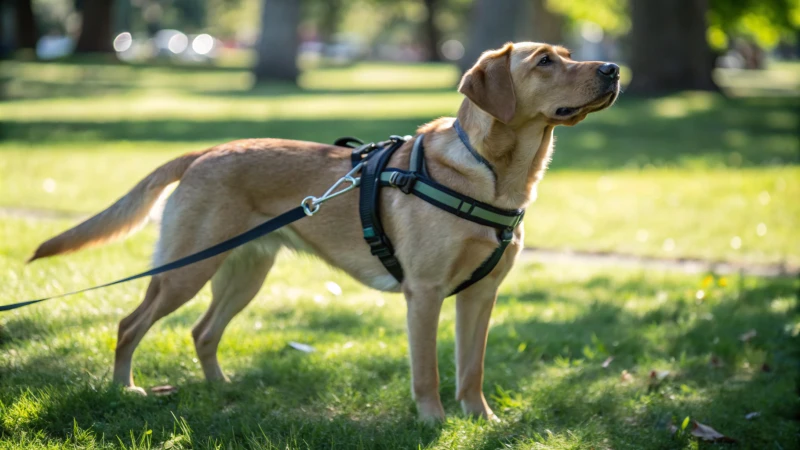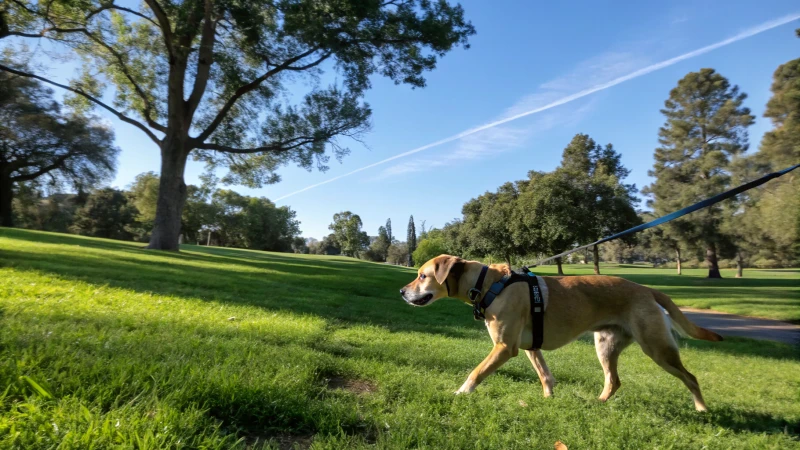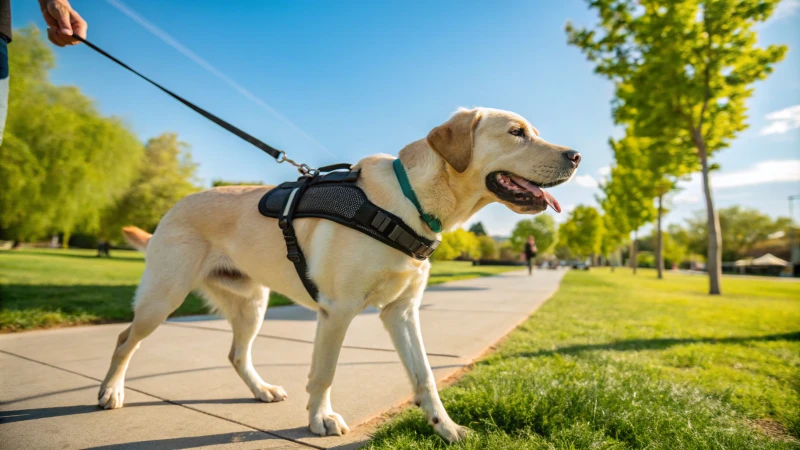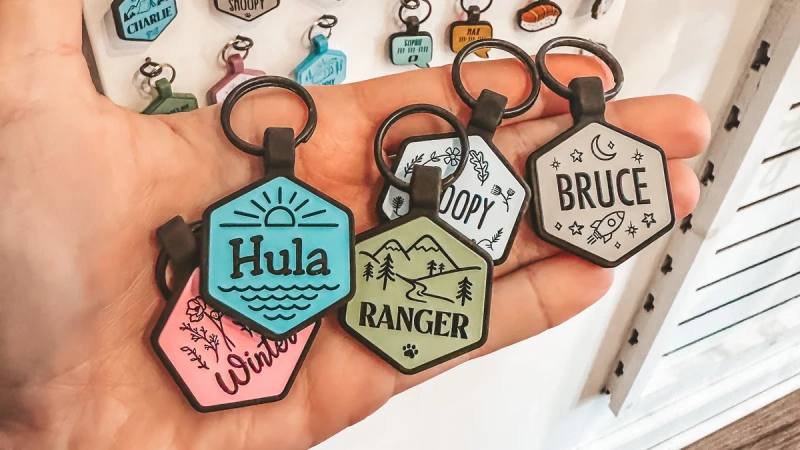
Ever feel like you’re pulling back and forth with your furry companion during walks?
Front-leash attachments on dog harnesses give better control. These attachments lower pulling by turning the dog’s movement toward you. This design works well for no-pull training. It also keeps your pet safe and comfortable. Many dog owners like this choice a lot.
I remember my first walks with Max, my lively Labrador. They felt like exercise, not a relaxing walk. But a front-leash harness helped everything. Suddenly, no more being pulled down the sidewalk. Max understood our path. This small change turned our walks better and deepened how we understood each other. Max’s safety increased with even pressure on his chest. This gave me peace of mind. Really. These harnesses help bond with your pet and keep walks both fun and safe. Safe and fun.
Front-leash harnesses reduce dog pulling effectively.True
They redirect the dog's movement towards the handler, reducing pulling.
Front-leash attachments are unsafe for dogs.False
They ensure safety by improving control and comfort during walks.
How Do Front-Leash Attachments Improve Dog Training?
Think about the first moment your dog pulled you along the street. Front-leash attachments on harnesses provide a solution. These attachments change crazy walks into easy strolls. They work well.
Front-leash attachments help with dog training. They give you more control over your dog’s steps. They really reduce pulling. These attachments allow better communication with your furry friend. Dogs probably walk calmly by your side. Training is very effective this way.

Better Control During Walks
Picture this: you walk your dog and instead of being pulled, the front-leash gently guides them to face you when they start pulling. It feels like having a magic trick that turns any walk into a calm and fun time. The first time I tried it with my energetic dog, the walk became a wonderful time together. This design avoids the struggle we usually have with back-clip harnesses. For people wanting to teach their dogs good leash habits1, this feature really changes everything.
Encouraging Calm Walking
These front-leash harnesses often promise "no-pull," and they work. They gently stop dogs from pulling forward by turning them back to us. Imagine this: each forward step gently leads them back beside you. This technique slowly helps them stay calm during walks. I remember seeing my neighbor’s lively retriever become a graceful walker with one of these harnesses. It was like magic! Understanding how it works is as easy as picturing a circle, where each pull brings them back, helping them stay calm over time.
Focus on Safety and Comfort
Traditional collars sometimes feel unsafe, especially for dogs with fragile necks or breathing problems. I used to worry about my small Pomeranian until I found the front-clip harness. It spreads pressure across the chest, giving comfort and lowering injury risks, which is very reassuring for small or flat-faced breeds. For those wanting a safer walk, choosing a harness that offers security and comfort is wise.
| Feature | Front-Clip Harness | Back-Clip Harness |
|---|---|---|
| Control | High; redirects pulling | Moderate; allows forward pulling |
| Safety | Reduces neck strain | Can cause neck strain if pulling occurs |
| Training Efficiency | Excellent for no-pull training | Less effective for pullers |
Better Understanding Between Dog and Owner
With a front-leash, communication with your dog becomes clearer. When they turn back to you, they seem more connected to your signals. This is great for those wanting to build stronger training habits2. By gently leading their movements, positive behaviors are reinforced, creating trust. No surprise, front-leash attachments are loved by trainers and pet lovers alike as they help build a special bond with our dogs.
Front-leash attachments reduce pulling behavior in dogs.True
The front clip redirects pulling dogs towards the owner, reducing forward lunging.
Back-clip harnesses are more effective for no-pull training.False
Front-clip harnesses are designed to discourage pulling by redirecting the dog.
Are Front-Leash Attachments Safer for All Dog Breeds?
Front-leash attachments interest many dog owners, especially in training their pets. But are these harnesses really safe for every dog breed? Maybe some dogs find them more helpful than others.
Front-leash attachments usually provide better control. These can reduce stress on a dog’s neck. This often results in more safety for many breeds. The right choice depends on the dog’s size, behavior and unique needs.

Understanding Front-Leash Attachments
I remember when I first tried a front-leash attachment with my playful Labrador, Max. Everything changed completely. These harnesses give better control, especially for dogs that love to pull. When Max tried to run ahead, the front attachment gently turned him toward me. It felt like talking to him through the leash.
Front-leash attachments are designed to provide better control over a dog’s movement, particularly for those that have a tendency to pull. This type of harness attachment redirects the dog3 towards the handler when they pull, making it easier to manage and guide.
Benefits Across Different Breeds
Small and Brachycephalic Breeds
My friend has a French Bulldog named Bella. A front-leash harness helped a lot. Bella used to choke with a collar because she loved exploring. Now, with the harness spreading pressure away from her neck, she is more comfortable.
Smaller breeds, such as Pugs and French Bulldogs, often benefit from front-leash harnesses as they distribute pressure away from the neck, reducing potential injury risks.
| Breed | Benefit |
|---|---|
| Pug | Prevents neck strain |
| French Bulldog | Reduces respiratory stress |
Large and Energetic Breeds
If a Husky has ever pulled you along the street, like Max did with me, control is very important. For big or energetic breeds, front-leash harnesses help manage walks. No more tug of war.
For larger or more energetic breeds like Labradors or Huskies, front-leash harnesses can be crucial for maintaining control during walks. These harnesses prevent the "tug of war" effect by redirecting their forward momentum.
- Labradors: Very strong; challenging with a regular leash.
- Huskies: Naturally inclined to pull; greatly benefit from redirection.
When Front-Leash Might Not Be Ideal
Even though I love these harnesses, they don’t fit every dog. My friend has a Greyhound, Oliver, who needs a special harness due to his unique body shape.
While beneficial for many, front-leash harnesses may not be suitable for breeds with unique body structures or specific behavioral issues.
Sighthounds
Greyhounds and Whippets have deep chests and slim necks. They need a snug but comfortable fit.
Breeds like Greyhounds or Whippets have deep chests and slim necks. A traditional front-leash harness might not fit snugly, risking discomfort or slipping.
- Greyhounds: Require harnesses made for their shape; designed for their unique body structure.
Dogs with Behavioral Issues
For some dogs with anxiety or fear-related behaviors like my cousin’s rescue dog Luna, a front-leash harness isn’t the best choice. Consulting a professional trainer4 offers advice on finding the right solution.
Considerations for Owners
before getting a front-leash harness think about your dog’s size and needs The perfect fit is key for comfort and safety For more information on different types of dog harness explore various training guides5 that detail their benefits and applications.
Front-leash harnesses reduce neck strain in Pugs.True
Front-leash harnesses distribute pressure away from the neck, reducing strain.
All dogs benefit equally from front-leash harnesses.False
Suitability varies by breed, size, and behavior; not all benefit equally.
How Do Front-Clip Harnesses Compare to Other Types?
Sometimes your dog seems to pull you during walks. This situation happens to many people. Front-clip harnesses might help. They really work well. Users often notice a big difference. Very helpful.
Front-clip harnesses help you guide your dog gently. They provide control when your dog pulls. These harnesses improve safety during walks. Training becomes easier with them. Unlike back-clip or dual-clip harnesses, front-clips excel in control and comfort. They really work well for training too.

Advantages of Front-Clip Harnesses
The first time I tried a front-clip harness with my very excited Labrador, Max, everything changed. Our walks became enjoyable. The design works wonders. The leash connects at the chest, gently pulling Max back towards me when he races ahead. It’s a subtle reminder saying, "We walk together." This feature makes them particularly effective for training6, as it discourages pulling and fosters better walking behavior.
Comparing Control Levels
| Harness Type | Control Level |
|---|---|
| Front-Clip | High |
| Back-Clip | Moderate |
| Dual-Clip | High |
In my experience, front-clip harnesses offer better control than back-clips. With Max’s old back-clip harness, he dragged me around like a small horse! Dual-clip harnesses give you choices, but the front-clip gives the best control for training.
Training Efficiency
People call front-clips "no-pull" harnesses due to their training effectiveness. Trainers love them. By redirecting a dog’s movement when they pull, these harnesses make it easier to teach calm walking beside their owner. I saw their power; Max soon walked calmly beside me instead of rushing forward. In contrast, back-clip harnesses might not aid much in training since they do not alter the dog’s direction when pulling.
Safety and Comfort Considerations
Front-clip harnesses offer comfort too by distributing pressure across a dog’s chest, reducing the risk of neck strain or injury—especially important for breeds prone to respiratory issues or neck problems like my friend’s French Bulldog. Switching made a big difference for them and is ideal for small or brachycephalic breeds7. On the other hand, back-clip harnesses may cause neck strain if a dog pulls too hard.
Versatility with Dual-Clip Options
If you enjoy flexibility, you might like dual-clip harnesses. They let you choose front or back attachments based on your dog’s actions. For those looking for flexibility, dual-clip harnesses might be appealing as they provide options to switch between front and back attachments based on the dog’s behavior or specific activities. However, while they are versatile and beneficial for owners who need a multi-purpose solution, they miss the focused benefits of front-clips for no-pull training scenarios.
Different harnesses have good points. If your dog pulls a lot like mine, front-clips are great for training and safety. Exploring options helps find the perfect match for your dog’s needs and temperament by exploring different options8.
Front-clip harnesses offer high control levels.True
Front-clip harnesses redirect dogs, enhancing control and reducing pulling.
Back-clip harnesses are ideal for training.False
Back-clip harnesses allow pulling, making them less effective for training.
What Should You Look for When Choosing a Front-Clip Harness?
Selecting a harness for your dog resembles picking the perfect shoes for a long walk. It must fit exactly.
A front-clip harness should fit snugly on your dog. It needs to offer comfort. The harness must come from durable materials. It helps control your dog’s pulling. Discomfort should not happen.

Importance of Fit and Comfort
I recall the first time using a new harness with my dog; it was a big change. Choosing the right one needs a good fit. A snug but comfy harness truly transforms our walks. Adjustable straps are very helpful, especially to accommodate your dog’s growth9 or weight changes with the seasons. Trying it on your dog first is important; you don’t want it too tight or too loose as it might cause discomfort.
Material and Durability
The harness material really matters. I once had a harness that frayed fast during play. Durable materials like nylon or polyester work well, with strong stitching at leash points being crucial. Breathable fabric prevents your dog from getting too hot, which is appreciated on sunny days. Eco-friendly options using recycled materials might also be available if you care about the environment and prefer eco-friendly10 choices.
Ease of Use and Adjustment
No one wants to struggle with their dog’s harness before a walk. Quick-release buckles are truly handy as they simplify everything for busy people. Step-in designs make preparation easier, while adjustable straps offer a perfect fit—useful for dogs with unique shapes or those still growing.
Control and Safety Features
I choose a front-clip harness for better walk control because my dog pulled so hard; it felt like sled training! The solid front clip redirects pulling effectively. Some harnesses really shine with reflective strips, perfect for evening walks, and having a handle on the back is useful in crowded areas11.
| Feature | Description |
|---|---|
| Fit | Adjustable straps, snug yet comfortable |
| Material | Durable, breathable, possibly eco-friendly |
| Ease of Use | Quick-release buckles, easy to adjust |
| Control Features | Front attachment point, reflective strips, handle option |
Training Capabilities
A front-clip harness really aids training by improving communication through redirecting forward pulls. Positive reinforcement pairs well to boost training success significantly when combined with consistency and love—truly changing our training outcomes efficiently.
A front-clip harness should have adjustable straps.True
Adjustable straps ensure a snug fit, accommodating growth and weight changes.
Eco-friendly harnesses are less durable than nylon ones.False
Eco-friendly harnesses can be as durable as nylon if made with quality materials.
Conclusion
Front-leash attachments on dog harnesses enhance control, reduce pulling, improve safety and comfort, and foster better communication between dogs and owners during walks and training.
-
Discover how front-clip harnesses transform walking dynamics by providing enhanced control and reducing pulling tendencies. ↩
-
Learn how front-leash attachments enhance communication between dog and owner during training. ↩
-
Discover why front-leash harnesses are preferred for controlling pulling dogs. ↩
-
Find expert trainers who can recommend the best harness for your dog’s needs. ↩
-
Learn about different harness types and their applications in training. ↩
-
Discover how front-clip harnesses aid in effective dog training by redirecting pulling behavior. ↩
-
Learn why front-clip harnesses are safer for breeds with respiratory issues or neck problems. ↩
-
Understand the advantages of various harness types to make an informed choice for your dog. ↩
-
Ensures a proper fit by teaching you how to accurately measure your dog’s size. ↩
-
Discover sustainable harness options that are better for the environment. ↩
-
Find harnesses with handles for increased control in busy environments. ↩



